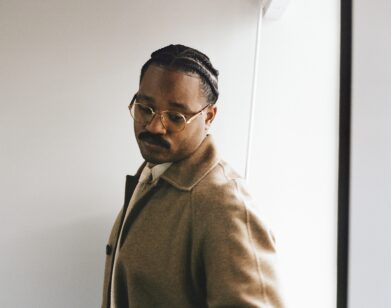The Legacy of Derek Jarman
Derek Jarman died in 1994 from an AIDS-related illness. When asked if the iconoclastic British filmmaker has any contemporaries, Nellie Killian, curator of the new retrospective “Queer Pagan Punk: The Films of Derek Jarman” at BAMcinématek, is at a loss. “He was a pretty singular artist. I can’t think of anyone who is definitively in his lineage,” Killian explains. “He feels like a pretty sui generis artist.”
BAM’s series exposes Jarman’s incredible range; from the punk classic Jubilee (1978), which chronicles a time-traveling Queen Elizabeth I, to Caravaggio (1986), the biography of the eponymous Italian Renaissance painter (and also the first film of his muse Tilda Swinton), to his final film, Blue (1993), a raw and intensely personal narrative account of his loss of vision before his death. Also featured are Jarman’s music videos for bands such as The Smiths and the rarely-seen short film In the Shadow of the Sun (1980), scored by experimental band and performance group Throbbing Gristle.
Throughout his oeuvre, Jarman moved his subject of the outsider across space and time, adapting aesthetics of dirty degenerates just as easily as those of high art classics. As Killian’s response would suggest, his work has proved inimitable and so markedly his.
In preparation for the series, which runs from October 30 to November 11, we asked Killian to expand upon Jarman’s work and legacy.
RYANN DONNELLY: My first question has two parts. We spoke last about the film series you curated for BAM “Punk Rock Girls,” which featured Derek Jarman’s film Jubilee. I’m curious if working on that series sparked your interest in hosting this retrospective, which was originally shown at the British Film Institute?
NELLIE KILLIAN: When I went to find a print of Jubilee for the “Punk Rock Girls” series I was told that all of these new restorations of Jarman’s work had come out, and that this big series was in the works for the BFI. So, yeah, it was kind of lucky that we wanted to show Jubilee in that series, because it let us know that all this Jarman work was available, and that the legwork had already been done to track everything down. From there we decided to do the full retrospective
DONNELLY: Have you added or omitted anything that was in the BFI series?
KILLIAN: The BFI retro is showing work by artists who were either associated with Jarman or artists who made work that was complimentary to his. Our series is a little more streamlined—we’re just showing his work, with the exception of the Ken Russell film The Devils, which Jarman did the set design for.
DONNELLY: Can you talk about the stylistic consistencies that you find so identifiable about his work?
KILLIAN: Derek Jarman is one these artists that’s so singular. His work is so personal that it really benefits from being able to see it all together. Even in a single film there will be references to incredibly high, classical art: Caravaggio, Marlowe, Shakespeare. But, then there are these other elements of punk traditions and moments from popular culture, like when he has Annie Lennox sing “Every Time We Say Goodbye” in Edward II. He has an incredible breadth of influences and this constellation of interests that, I think, is so particular to Jarman. Getting to see all the work together just enriches that. You get an incredible sense for what he was about and can appreciate how he was pulling all these things together and thinking about the world.
DONNELLY: Do you feel there’s anything specific to this particular point in time, rather than in the last 10, or even five years that makes looking at his work so relevant?
KILLIAN: We actually did a program called New Queer Cinema featuring Jarman about two years ago. At the time, it had been about 20 years since this watershed moment around 1991 when Edward II, Gus Van Sant’s My Own Private Idaho, and Poison by Todd Haines came out. They were all these really incredible, honest, adventurous, angry movies. I think one thing that’s interesting about that series is that it seems to take about 20 years for something to really feel like “the past”—not an extension of the present. I can’t say that there would be any bad time to see Derek Jarman films, but I do feel like it’s interesting to assess them 20 years later.
DONNELLY: Who do you consider to be Jarman’s contemporaries, or where do you see his influence?
DONNELLY: Do you have a personal favorite in the series?
KILLIAN: I’m really excited to see War Requiem and the restoration of Caravaggio. I also hear the archival print of Blue is going to be beautiful.
“QUEER PAGAN PUNK: THE FILMS OF DEREK JARMAN” OPENS WEDNESDAY, OCTOBER 30, AT BAMCINEMATEK IN NEW YORK AND RUNS THROUGH NOVEMBER 11. FOR MORE INFORMATION, VISIT THE BAM WEBSITE.







